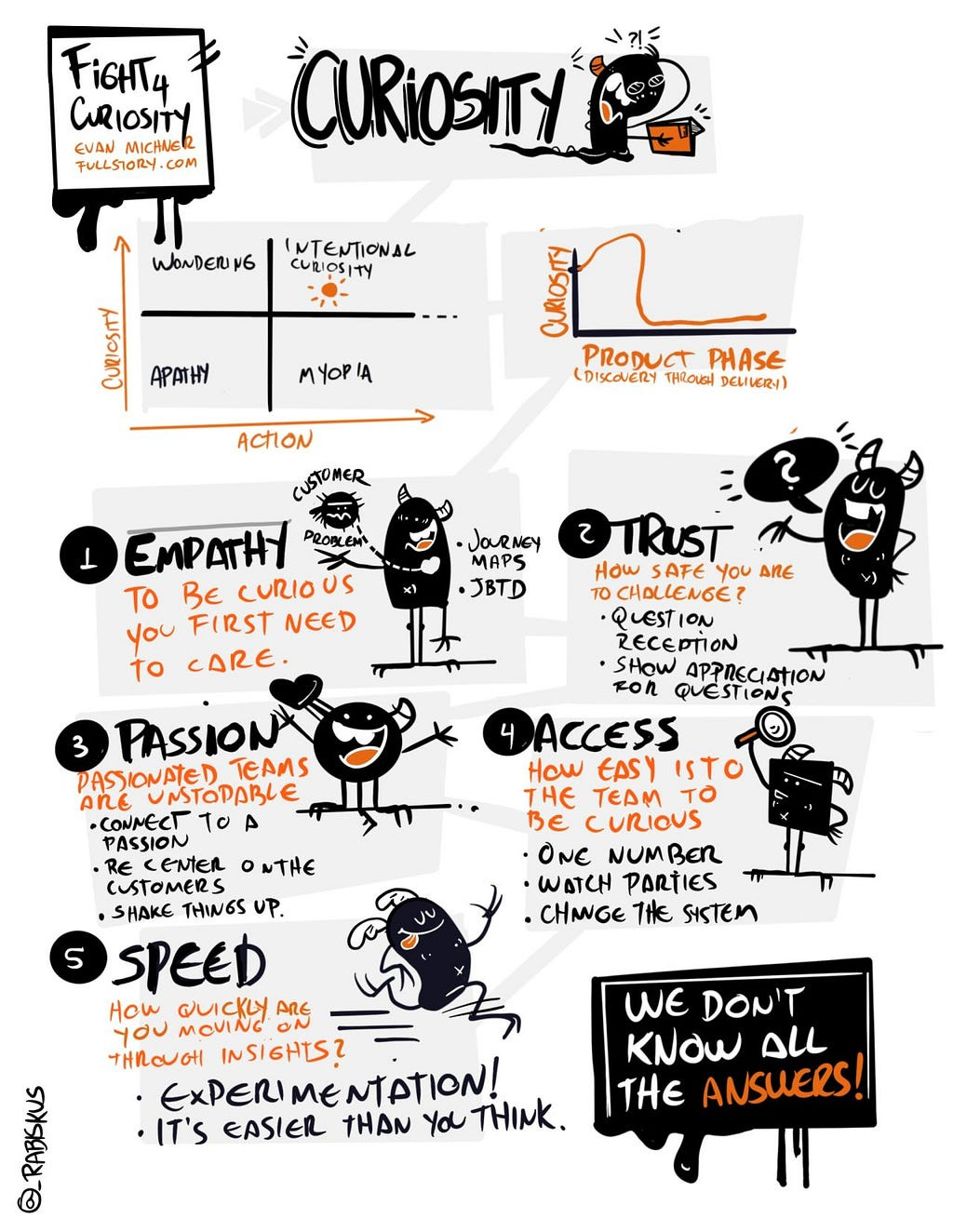Fight for Curiosity
Product requires disciplined, intentional curiosity
In the healthiest high-performing product teams, curiosity is a compulsion. A relentless drive to learn that sparks action and differentiating value faster than the competition.
Those teams know how powerful curiosity is — and how easy it is to lose. If you don’t fight for curiosity, it disintegrates. Your best people leave and your product drifts.
Product is the art of disciplined, intentional curiosity.
Four Zones of Operation
Intentional curiosity comes into focus when placed in contrast to the other three zones: Apathy, Wondering, Myopia.
🤷🏻♀️ Apathy. Danger zone. Though easy to drift into — do the meetings, answer the emails, pull the data. Rinse, repeat. All the sudden, it’s been a while since you’ve talked with a customer or asked a question from the data. You stop caring about the customer and the product.
🤔 Wondering. Diving deep into random rabbit holes. Learning in spurts and sprints without a step towards action. Perhaps even taking pride in “learning for the sake of learning.” Endless cycles of wondering that leave the customer stranded. Curiosity must translate to clarity and direction. The magic is on the follow through.
🔬Myopia. And in the bottom right corner, the product manager myopically focused on shipping That Feature — strong sense of purpose. Never late. But not curious enough to think critically or ask questions.
🧐 Intentional curiosity. Choosing your questions with precision and pragmatism, and finding the right way to ask them. It’s lifting your eyes while executing with speed. It’s caring enough to ask, “Why?” and pivoting where necessary. It’s a motion, a feeling that’s honed with experience. Curiosity and action = Consistently delivering on the right problem, faster than the competition.
Where are you operating from right now?
Curiosity in the Lifecycle
A Product person might even move through a few zones within a single arc of work.
At the start of research/discovery, you’re on fire! You’re talking with customers, combing through data, sizing up the competition.
But as you move into validation and delivery, your aperture narrows and shifts, especially under pressure — just like a camera lens: You’re letting less (or different) light in. Your sense of curiosity wanes to make space for an increased focus on delivering, primed to increase the chances of delivering the wrong thing.
Curiosity Cocktail
Product People — So much of our job feels like we must know the answers. What’s in the sprint? What are the biggest bets for this quarter? How does this fit into the annual strategy? Where are we going and what’s our vision?
You become an action-oriented answering machine. It’s habit forming, and can cause you to go off course into Apathy, Wondering, or Myopia. Interrupt the cycle; it’s our job to fight for curiosity.
Thanks to the incredible work of João Reis, we can visualize this as:

For now, a few quick tips. Stay curious about your customer, your product, your craft:
Trust is an unlock and an outcome of a culture of curiosity. It’s a loop that builds and builds. When you have a team that feels safe, their minds aren’t consumed with calculating the risks of asking a question. Giving voice to curiosity carries risk — how safe is it to ask questions in your org?
Look at your product portfolio: What new learning might cause you to stop something mid-flight? What would it take to over-power the inertia?
Teams need access. Is the data accessible, usable? How much friction is there is getting time with a customer?
Struggling to care enough to be curious? It’s easy to blame your environment, your leader, your projects. But look inwards first: Find something related that you do care about, and connect it back for motivation. Connect what you’re working (which is important, but might not be interesting) to something that interests you. Does it help tell a story for your career? Learning a new slice of technology? This is a tool that’s often recommended to neurodiverse folks who operate more with an interest-based nervous system rather than an importance-based nervous system — useful for anyone to consider.
For those of you who use your own product each day, what a double edged sword! So easy to become numb to the papercuts and gloss over the opportunities. Don’t let a week go by without talking to a customer for their perspective.
Curiosity is contagious. And when it spreads, it creates a culture of curiosity. Make a note of the questions you’re asking individually and publicly. Fan the flame.
At FullStory, we use a simple exercise called One Number. Each PM brings one piece of data to our team meeting. It helps ensure we’re constantly in the data, and always generates rich dialogue: Each insight sparks a flurry of questions, and curiosity takes over!
Curiosity requires trust and humility. An empowered org where teams can ask questions and prioritize the answers based on clear frameworks and goals. How would your team rate trust?
When asking questions, pair curiosity with context. “I’m curious: Where can I find more data on X? Context: Was talking with a customer yesterday and…” Disarming. Brings others along, rather than, “What’s the engagement data on that feature?”
As you interview, know that the interviewer is paying attention to the questions you’re asking, too. Curiosity is a key characteristic of product managers. Showcase your curiosity by digging in to understand the customer, the business, and the team.
Above all: Product work is a joy! Stay curious, friends.




